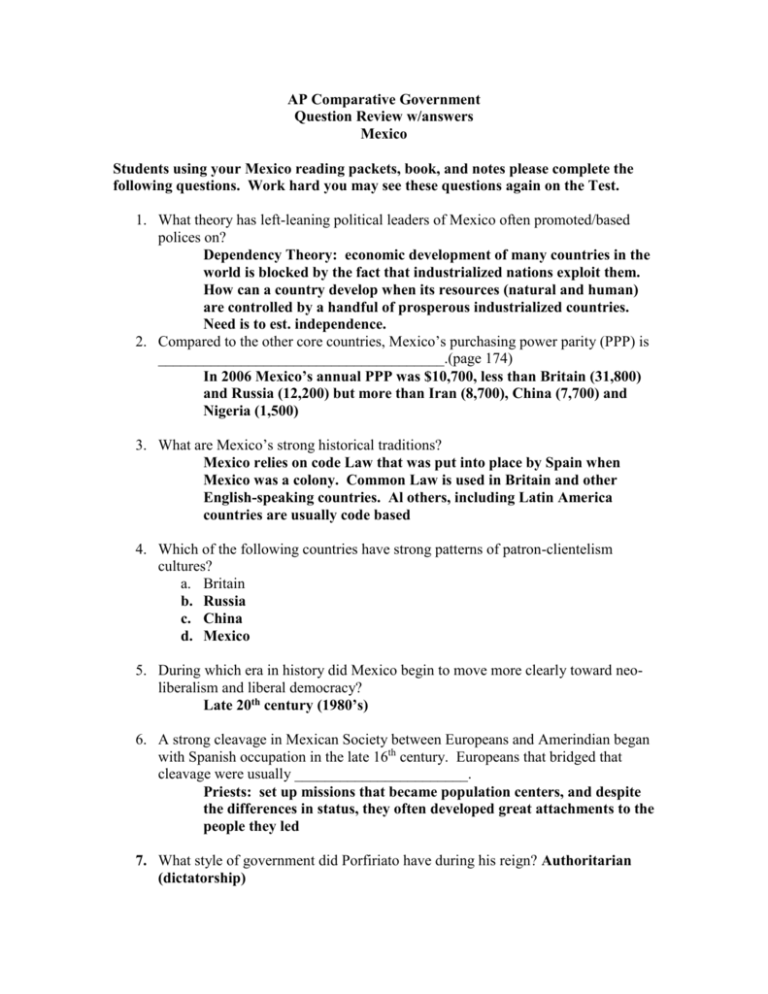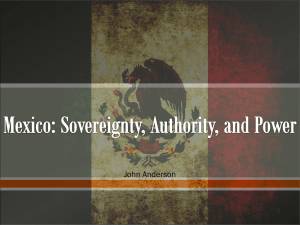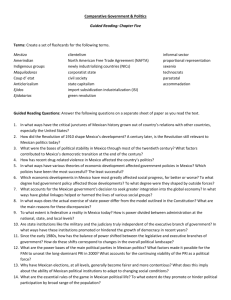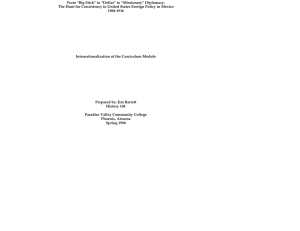Mexico Review Questions 08 with answers
advertisement

AP Comparative Government Question Review w/answers Mexico Students using your Mexico reading packets, book, and notes please complete the following questions. Work hard you may see these questions again on the Test. 1. What theory has left-leaning political leaders of Mexico often promoted/based polices on? Dependency Theory: economic development of many countries in the world is blocked by the fact that industrialized nations exploit them. How can a country develop when its resources (natural and human) are controlled by a handful of prosperous industrialized countries. Need is to est. independence. 2. Compared to the other core countries, Mexico’s purchasing power parity (PPP) is ______________________________________.(page 174) In 2006 Mexico’s annual PPP was $10,700, less than Britain (31,800) and Russia (12,200) but more than Iran (8,700), China (7,700) and Nigeria (1,500) 3. What are Mexico’s strong historical traditions? Mexico relies on code Law that was put into place by Spain when Mexico was a colony. Common Law is used in Britain and other English-speaking countries. Al others, including Latin America countries are usually code based 4. Which of the following countries have strong patterns of patron-clientelism cultures? a. Britain b. Russia c. China d. Mexico 5. During which era in history did Mexico begin to move more clearly toward neoliberalism and liberal democracy? Late 20th century (1980’s) 6. A strong cleavage in Mexican Society between Europeans and Amerindian began with Spanish occupation in the late 16th century. Europeans that bridged that cleavage were usually _______________________. Priests: set up missions that became population centers, and despite the differences in status, they often developed great attachments to the people they led 7. What style of government did Porfiriato have during his reign? Authoritarian (dictatorship) 8. What is the common characteristic between the Russian, Chinese, and Mexican revolutions of the early 20th century? All resulted in one-party states 9. What were the reforms from the sexenio of Lazaro Cardenas? (page 185) think economic Ejidos, nationalization of industry, inclusion of peasant and union organization in policymaking, investments in public works He followed Import substitution industrialization (ISI) which employs high tariffs to protect locally produced goods from foreign competition, government ownership of key industries, and government 10. The division between tecnicos and politicos among the PRI leaders developed because of disagreements about Economic development 11. Compare and contrast Northern Mexico and Southern Mexico Voters in the north are more likely to vote for PAN 12. What has happened to voter participation rates in Mexican presidential elections since 1994? The voter rate reached its height in 1994, and has declined in the two elections since 13. What type of cooperation do interest groups give to the Mexican government? How does that compare to China’s interest groups? Refuse to cooperate with the government /the government has to bargin with or bribe the interest groups 14. What does Mexico’s high Gini coefficient (.50) mean? Has a great deal of inequality 15. Give a list of reasons why Mexico cannot yet be declared a stable democracy. Country does not show a consistent democratic practices for as least 40 years (still have corruption) 16. Fill in the chart below: Geographic Features North Flat Desert Central Mountains ranges: 3 major climate regions South Farming Agriculture Economy/Human Demographics Industry US like Subsistence Farming Culture (Indian) Rural Party Affiliation PAN Large and small businesses Urban Mexico City PRD PRI 17. Which of the following countries directly elect both a president and representatives to a legislative body? a. Britain b. Russia c. China d. Mexico 18. Which of the following countries combines a plurality (first-past-the-post) electoral system with proportional representation. a. Britain b. Russia c. China d. Mexico 19. What Mexican government program is representative of a socialist ideology? (185) The ejido system 20. What significant change did the presidential election of 2000 bring to the political system? A non-PRI candidate won 21. What is the best example of a Mexican para-statal? PEMEX 22. What is the main reason that an increasing number of women have been elected recently to the Mexican legislature? An election law requires political parties to sponsor women candidates 23. What power does the Mexican Supreme Court have? Exercise judicial review, on paper but not in reality 24. What major change happened to the Mexican military since the mid-20th century? No longer has policymaking power 25. List the major problems for the Mexican Economy. (199-200) overreliance on one product for export, high national debt, a large gap between the rich and the poor, rapid and unplanned urbanization 26. Most accusations of corruption among Mexican police officers stems from their involvement in Drug traffiking 27. Russia is to the Chechen rebellion as Mexico is to the Zapatista Rebellion 28. Using the picture above answer the following: The arrows on the map above point out Mexico’s Maquiladora district Legislative Elections 2006 PRI 122 PAN 206 PRI 39 PRD 159 Other 13 CHAMBER OF DEPUTIES PAN 52 PRD 36 Other 1 SENATE 29. The patterns of party affiliations in Mexico’s legislature shown in the chart predict that in the near future the government will experience Gridlock 30. What change in patterns of party affiliations in Mexico’s legislature from 20032006? PRD gained seats in both houses 1. The PRI Regime that dominated Mexican politics for than 70years has been described as the “perfect dictatorship”. How did the party maintain control over Mexico for so long without facing significant challenges to its party? a. Founded by political elites i. Work out conflicts within an overarching structures of compromise than to continue to resort to violence ii. Operated under different names till 1946 b. Mass based party that drew support from all classes in the population c. Generate support for government, organize the electorate: i. To vote for their candidates ii. Distribute jobs and resources iii. In return loyalty d. Corporate interest of party councils i. Confederation of Mexican Workers (CTM) 1. Labor 2. most organized 3. most powerful 4. small farmers were grateful and dependent on rewards of land and jobs 5. Remained important to PRI ii. National Peasant Confederation (CNC) 1. peasant unions iii. National Confederation of Popular Organization (CNOP) 1. popular sector 2. small businesses 3. community based groups 4. public employees e. Functioned through extended networks that distributed public resources i. Jobs, land, development, projects, and access to public services f. How did it work? i. Created networks of supporters (patrons) ii. They “delivered” votes iii. Clients: traded allegiance to access public works g. Worked because PRI candidates won by overwhelming support h. Other influences: i. Fraud ii. Ability to distribute government largesse are central explanations for these numbers iii. Extremely well organized party iv. Only party that could boast a network of constituency organization in villages and urban community v. Intimidation vi. Fear and violence vii. Informal systems viii. Use of the media to promote the Party and squash unfavorable stories i. Identified with (CTM and the CNC) i. Corruption, bossism, centralized control, lack of effective participation j. By 1980’s new generations were unhappy and opted to question the PRI k. New ways?? i. Restructure and reform ii. CNOP was replaced – non-class based citizen 2. What events and developments account for Mexico’s transition to a more democratic system in recent years? a. Voters are younger, more educated, more middle class, and more likely to live in urban areas than they were in the days of PRI success b. 1988: only 27.3% of the population of Mexico city voted for PRI; 34.3% of urban areas c. Elections: i. More competitive and fairer ii. 1990 electoral commission was created to regulate campaigns and elections 1. 1996 became foully independent of government iii. All parties receive government funding iv. All have access to the media v. Limit on campaign spending and contributions (level the playing field) vi. Voter registration was reformed (fraud to become a thing of the past) vii. Election monitoring d. 1994: i. Elections have been fairer ii. Congressional, state, and municipal elections reinforced the impression that electoral fraud is on the wane in many areas e. Familiar how political system works and how they can extract benefits from it i. Understand informal rules of the game ii. Helped maintain political stability iii. Connection , even the poorest, are able to interact with public system iv. Get something out of the system f. Increasing number of citizens are seeking to negotiate with the government i. Basis Citizenship rights g. Interested in objective information and analysis of public opinion i. Influence content and timing of government decisions and development of strategies in election campaigns ii. 1994-2000 1. politicians, citizens, and political activists closely followed popularity polls 2. monitored how the image of their contender could be molded to capture higher voter approval 3. new to Mexico: hard to assess attitudes h. Role of media i. Past: could not be openly opposed to government 1. used to reward sympathetic news coverage 2. penalize coverage considered hostile 3. advertising placed by the government 4. quashed stories that reflected ill of the party ii. Today: 1. more independent 2. diversity of opinion 3. several major tv networks 4. access to CNN and other global networks 5. hear a wider range of opinion 6. reporting of debates about public policy 7. criticism of the government i. Democratic Idea: page 247 i. Citizen rights to free speech and assembly, free and fair elections, and responsive government are major reasons that the power of the PRI came under so much attack 3. Describe the geographic, demographic, and economic factors behind the significant regional differences that exist in Mexico, and explain how those differences affect the country’s politics. a. Most geographic diverse country in the world i. Snow-caped mountains, volcanoes, costal plains, high plateaus, fertile valleys, rain forest, and desert ii. Shares a 2000 mile boarder with US iii. Share 600 mile boarder with Guatemala iv. Share a 160 mile boarder with Belize v. Sierra Madre Occidental, and Sierra Madre Oriental 1. notes for peaks and valleys, plateaus, and valleys 2. microclimates, plants and animals vi. Made communication and transportation difficult and infrastructure expensive b. “Human landscape” 4. More than any other country, Mexico lies in the shadow of the United States. How has proximity to the “colossus of the north” affect Mexico’s historical development, national identity, and foreign regions? a. Historic relationships i. Recognized those that distinguish themselves in confrontations with the US 1. Remember the Alamo 2. Mexican War 3. Loss of land to US ii. Revolution of 1910: emphasis the uniqueness of the country in terms of its opposition to the capitalists and militarists, of the northern country iii. 1970’s leading Third World Countries 1. argue for enhanced bargining positions in relations with countries of the north iv. NAFTA 1. reality of information, culture, money, and people flowing back and forth across the boarders v. Labor migration; 1. Enter US as workers 2. many return to towns and villages 3. largest ethnic population in US 4. Mexican culture is preferred to US 5. influenced by strong US mass culture, including, popular music, movies, television programs, fast food, and consumer goods 6. Inability of Mexican economy to create jobs 7. cash remittances that migrants abroad send home to families and communities are now almost as important a source of income as PEMEX oil sales 8. Migration issues with US a. Us under pressure to control the boarders b. Convince US Govt. that allowing more migrants to cross the boarder legally would actually enhance US security 9. Differences in wages between US/Mexico vi. Economic Challenges 1. Integration and what that means in a competitive international economy 2. final abandonment of Mexico’s sovereignty 3. market-based/outward oriented development a. affect on peasants, workers, and national identify







